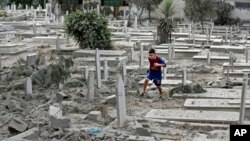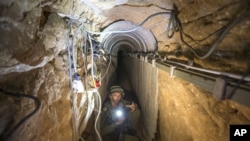The Israeli military has provided its most detailed assessment yet of the conduct and impact of the Gaza war, including photographs indicating that militants stored and fired rockets from schools and a breakdown of the toll inflicted on Hamas.
In a briefing at its headquarters in Tel Aviv, the Israel Defense Forces presented a minute picture of the structure and capability of Hamas and other militant groups operating in Gaza, an effort to explain the severity of the threat Israel faced and justify Israel's heavy tank shelling and air strikes during the 50-day conflict -- tactics that drew international criticism.
Among the evidence laid out by a senior military officer were details of the ranges and number of rockets fired by Hamas and Islamic Jihad, photographs showing how rocket launchers were hidden in graveyards and a school playground, and how tunnels were used to carry out and escape from the site of attacks.
One set of photographs showed a school by day, its central yard empty. By night, rockets looked to be stockpiled in the yard. At another school a canopy, where a hole had been torn for a rocket launching, was further frayed after a projectile was fired from underneath, he said.
“We're dealing with a carefully structured and in many cases well trained terrorist force,” said the general staff officer, who spoke on condition that his name not be used.
“Hamas has at least 16,000 operatives organized into six brigades across the Gaza Strip, each with its own commander, while (Islamic Jihad) has a similar structure and a total of around 6,000 operatives.”
The war, the longest Israel has fought since it withdrew from the narrow coastal enclave in 2005, left more than 2,100 Palestinians, most of them civilians, dead, the Palestinian health ministry said. Israel said 67 of its soldiers and six civilians were killed.
After two failed attempts, an open-ended ceasefire was struck by Egyptian mediators on Aug. 26. Detailed talks on a longer-term peace are supposed to start in the coming weeks, although already there are doubts about their prospects.
Civilian deaths
On the day before the war began, the IDF said it estimated militants held 10,000 rockets in Gaza, including 350-400 with a range of up to 80 km and a few dozen with a range of 160 km, reaching Jerusalem. On top of that, the intelligence officer said, there were “thousands upon thousands” of mortars.
Around 4,000 rockets were fired during the conflict and 3,000 destroyed by Israel's operations, leaving between 2,500 and 3,000 in the hands of Hamas, Islamic Jihad and other groups.
The officer described that as a “major degradation” of the groups’ capabilities, alongside the destruction of 32 tunnels built from Gaza into Israel and steps to hit Hamas's finances.
He presented figures showing that civilians made up the majority of those killed in the conflict, saying that of 2,127 Palestinian deaths so far verified by Israel, 706 were civilians and 616 militants.
A further 805 are listed as “unknown”, but the officer said once verification was complete it was likely 40-45 percent of them would be found to be militants and the remainder civilians.
He said the heavy civilian death toll was the result of Hamas and others conducting operations from densely populated areas or employing “operatives” who may not have had a direct militant affiliation but still participated in some way.
During the war, at least 6 U.N.-run schools were hit by Israeli artillery, killing at least two dozen people and drawing heavy criticism of Israel. Militant rockets were also found in three empty U.N. schools.
The pictures shown by the Israeli officer were of other, non-U.N. schools.
“We're a moral military. We want to learn from our mistakes,” he said, adding that civilian casualties were “a big issue in the world” and one that Israel was keen to address.
With the war over, various investigations are set to begin, including an internal Israeli military one, another by Israel's government watchdog and a third by the UN's human rights commission, already criticized in Israel.
While the officer, occasionally sipping tea from a U.S. Defense Intelligence Agency cup, said Hamas had not managed to surprise Israel during the war, he acknowledged that an attack by commandos who swam from Gaza into Israel was well planned, used advanced, Western equipment and was carried out by militants who were “in very good shape”.
Other near surprises were the extent of the tunnel network dug by Hamas and its attempt to use a small drone-like plane, although it carried no weapons or explosives.
Reconstituting those capabilities would take time, he said, adding that this war had been more successful than previous ones in 2012, 2008-9 and 2006 in knocking Hamas backwards. But he still referred to “the next escalation” with Hamas, seeming to accept that another conflict in Gaza was all but inevitable.











